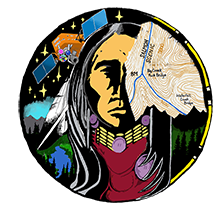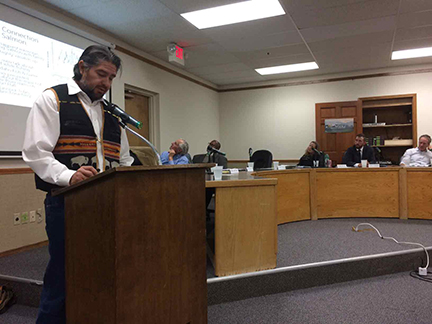


As small rural towns in Idaho feel the devasting economic consequences of dismal returns of salmon and steelhead, a panel discussion entitled Salmon: Our Fish, Our Past, Our Future took place on the 22nd of October at the Salmon City Center in Salmon, Idaho. The panel was moderated by Dr. John Freemuth, a professor of Public Policy and Administration at Boise State University. I was asked by the organizers of the event to be on the panel and accepted.
Dr. John Freemuth began the discussions by summarizing the comments made by Senator Mike Simpson in his keynote speech at the Andrus Center Environmental Conference on salmon, energy, agriculture and community this past March. He also stated the purpose of this panel was to invoke conversations and perspectives on salmon from the Bonneville Power Administration, Tribes, small town communities, and Idaho Outfitters and Guides. As part of the event, written questions from the audience were answered and discussed by the panelists.
The panelists included Meryl Beyeler a member of Governor Little's Salmon Work Group, John Williams of the Bonneville Power Administration, myself, Dr. Helen Neville senior scientist for Trout Unlimited, Aaron Lieberman Executive Director of Idaho Outfitters and Guides Association, and Jim Norton Project Coordinator for the Columbia Rediviva and an international river guide and film producer. Except for the BPA representative, all other panelists provided varying perspectives that supported the need for improving Idaho's rural economies, better environmental stewardship, and that the breaching of the lower four Snake River dams is necessary to promote wild salmon recovery.
Mr. Beyeler, who is also a rancher and Chair of the Lemhi Regional Land Trust, read a passage from Osborne Russell's classic book Journal of a Trapper. The passage read described Russell's observations on the abundance of Idaho's fish and wildlife in the early 1800s and then he spoke about how little wildlife he sees today in the same areas described by Russel. Mr. Beyeler also showed photographs of stream restoration work he has done on the Lemhi River which resulted in increased salmon spawning. Mr. Beyeler concluded by saying something must be done to protect Idaho's fish and wildlife.
Mr. Williams provided information on BPA's energy delivery system, which spans several western States. He also stressed BPA track history on making timely debt payments to the Federal Treasury and that energy revenue generated pays for the operations and maintenance of the system. He also said that the report of $16 billion spent on recovery of Salmon also includes funding for a variety of fish and wildlife habitat restoration projects that are not directly related to salmon recovery. He also said he himself developed an economic report on the operations of the four lower Snake River dams earlier in his career but did not indicate whether this information was publicly available. Mr. Williams also informed the full house about the River Systems Operations Environmental Impact Statement (EIS). He stated that approval of the EIS has been fast tracked by the Trump Administration, and that the BPA has shortened the public comment period to meet the schedule. The action of the BPA is to approve system operations of 14 federal projects on the Columbia and Snake River systems. One alternative of the EIS includes the breaching of the four lower Snake River dams in Washington.
I followed Mr. Williams in the line-up and introduced myself as a Newe tribal citizen and editor for the Journal of Native Sciences. I showed a graph depicting the decline of Salmon overtime and gave personal testimony on how the dams have eliminated salmon on the Upper Snake River and may even cause the salmon to go extinct in the Agaiba or "Salmon Waters", which is now known as the Salmon River. I also talked about how the decline of salmon is related to the landscape conversion of the Palouse Prairie into agriculture in northern Idaho and southeastern Washington, as agicultural products produced on the Palouse are exported via the Snake and Columbia River system. I also stressed the need for small towns like Salmon to develop a vision on salmon recover and the need to organize a multifaceted protest to gain political support for breaching the dams. Here is a link to a transcript of my presenation. I concluded by saying "water is the first medicine, and if we take care of the water the salmon will be taken care of."
Dr. Neville and Jim Norton presented information on how the best available science supports dam breaching as the only viable option for wild salmon recovery. Mr. Lieberman presented information on how the economy of small rural towns are declining due to poor salmon and steelhead returns which hurts outfitters and guides the most, but also spin-off businesses in the area. Mr. Lieberman expressed frustration that the state of Idaho does not appear to even want to talk about the potential for dam breaching and small-town economies like Salmon and Riggins bear the burden.
Support for the panel discussion was provided by The Lemhi County Historical Society and Museum, The River of No Return Chapter of Trout Unlimited, The Sacajawea Center, The Smithsonian Institute, The Governor's Lewis and Clark Trail Committee, The Idaho Humanities Council with donations from Artis Hewitt and Idaho River Journeys.
Email the editors for more information.